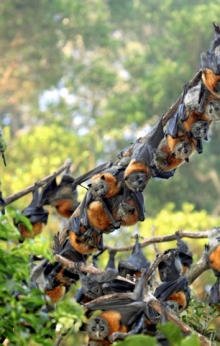Living with Flying Foxes
The number of flying-foxes in camps around Sydney and along the east coast fluctuates throughout the year. Some of these camps are located close to peoples’ homes. Some camps may seasonally increase in size to impact on nearby houses. Close proximity to a flying-fox camp may raise the following concerns:
Noise
Day-time noise – people living near a flying-fox camp will be familiar with the early-morning return of the animals from their nightly foraging for food.
Night-time noise – heard when flying-foxes are feeding in near-by trees. This noisy squabbling is vital to their efficient spread of seeds (read more about flying-foxes eating and drinking). It may be disturbing to some, however it is worth noting:
- Flying-foxes will only be present while the tree they are visiting is in fruit or flower
Mess
Mess is most likely to occur where flying-foxes are feeding. Their rapid digestive system means they urinate and defecate within half an hour of first feeding. The problem will resolve when fruiting and flowering has finished.
- Covers such as sails can be erected over areas needing protection
- Clothes should be taken off the line at night while flying-foxes are feeding in the area
- The sooner the mess is removed the easier it is to shift, (eg. hard surfaces such as decking should be sprayed with a hose and scrubbed with a stiff brush)
Smell
At certain times of year flying-foxes produce an earthy, musky smell.
- It may be associated with mess beneath their feeding and roost trees
- It may be the scent associated with mating (strongest during February to April)
Fruit Tree Damage
While their preferred food is the nectar of native trees, flying-foxes will visit orchard and backyard fruit trees when other food sources are scarce. To prevent damage, and minimise the risk of harm to our local wildlife (possums, bats, birds, reptiles), fruit trees can be safely netted.
Read more on safely netting fruit trees and vegetable gardens.
If an animal does become entangled in netting, contact your nearest animal rescue organisation. Do not attempt to release them yourself – in particular, bats should be handled only by trained, vaccinated personnel.
Relocation Attempts
There are sometimes calls for camps to be ‘relocated’ and occasionally efforts are undertaken to disturb camps in an attempt to chase flying-foxes off.
To date, no cost-effective, reliable method has been found to achieve camp ‘relocation’, with many merely disturbing and stressing the bats.
Read more on relocation of camps
Disease
Like all other animals, including humans, bats can host viruses and parasites.
- Australian Bat Lyssavirus (ABL) – One person has died from this virus following a bite from a flying-fox.
- Hendra Virus – no person has contracted this virus from a flying-fox. Four have died by contracting this virus from horses. Further deaths are avoidable if vets and other people dealing with horses follow the recommended hygiene protocols.
People should not touch or approach flying-foxes which are on their own, hanging close to the ground or are on the ground. Instead, contact your local rescue organisation to deal with any bats in need of assistance. It is important to remember to keep pets away from injured animals as well.
What you can do
- Follow guidelines to safely-net backyard fruit trees
- Plant food trees for wildlife, but only those which are found naturally in your area – ask your local council
- Protect remnant native vegetation on your own property
- Improve bushland and habitat quality by joining a local bushcare group – check with your local council
- Minimise flying-fox camp disturbance, especially during breeding season
- Report any sighting of banded or injured flying-foxes or the establishment of new camps
- Encourage and support humane, non-lethal crop protection
- Educate others on the importance of flying-foxes
- Support organisations such as Ku-ring-gai Bat Conservation Society

